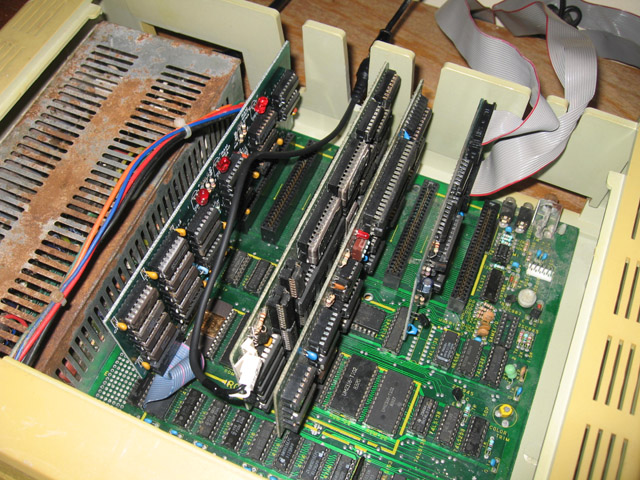Turning an Apple II+ Clone into a CP/M Workhorse
Why CP/M?
In the early '80s, CP/M was the standard DOS for 8-bit business micros. These micros were expensive. Perhaps because of this CP/M developed a somewhat overrated reputation. People would speak of it in hushed and reverent tones! In reality, it was a competent DOS but no more (and sometimes much less) than other more machine-specific DOSs around at the time.
As they were way beyond my finances at the time, I've always wanted a CP/M micro to play around with. My Osborne 1 was my only CP/M machine before this project, but it's a grumpy old beast at the best of times and the screen is tiny. I don't like to use it for long stretches at a time. Enter the RX-8800
 Figure
1. The RX-8800. Extremely yellowed but now alive!
Figure
1. The RX-8800. Extremely yellowed but now alive!
The Apple haul included three of these unusual and little known computers in various states of neglect. Although not shaped like a traditional Apple II (like the Redstone) the RX-8800s have exactly the same clone board. These units were in very bad shape and in fact one was missing bits and pieces. I used two of them as a source of parts for the Apple Europlus, Redstone and the one remaining RX-8800. Eventually, I managed to restore the latter to a fully working state.
Apple IIs and II+s were often run as a CP/M business machines back in the day. In fact, Microsoft's first hardware project was the Softcard, a plug in card containing a Z-80 processor (needed for CP/M) for just this purpose.
The haul contained a stack of add-on cards and amongst them was a couple of these Z-80 Softcard clones. Also in the stash were a number of 80 column cards (80 characters per line is typical of CP/M applications) and two 16k expansion (language) cards which could be used to give the Apple II 64k of usable RAM (also necessary for CP/M).
All the ingredients were there, to deck my remaining RX-8800s in CP/M functionality.
Adding a 16k Language Card
First step was to add a 16k card and see if it worked. I had two cards and I tested both. Hmm..one worked but not the other. A close inspection showed a non-DRAM chip had been accidentally inserted in a DRAM socket on the faulty unit (opps). This was replaced with the correct chip. I now had two working cards.
Slipping in a card to slot zero and loading DOS 3.3, I found it allowed Integer BASIC to be loaded into RAM on booting. Cool!
Adding the Z80 Card
 Figure
2. The Z-80 Card
Figure
2. The Z-80 Card
The next task was to add the Z80 Card. I had the Softcard manual (Vols I and II) which stepped me through the process. Following the instructions, I added the card to a spare slot, inserted a disk called "CP/M Master" (which I found in a disk caddy in the haul) and switched on. Viola! One CP/M boot-up screen became visible (albeit in 40 columns).
The first thing I did was to copy the CP/M Master disk contents to a brand-new 5.25 inch floppy. You're never quite sure how long this old media is going to keep working and the OS disk is the one disk you don't want to lose.
Adding the 80 column card
 Figure
3. The 80-Column Card
Figure
3. The 80-Column Card
I anticipated that adding this final piece of the CP/M hardware would be more difficult than the other two. The reason: I had no documentation what so ever. However, enter Google and the Vintage Computer Forums and I soon got some advice on what was required. Some trial and error followed but I found that what I had to do was to connect an RCA socket via a short cable to a couple of pins on the card. The monitor would then plug into this socket rather than the motherboard one. A cable wired just like this was in the haul, and it obviously had been used for this purpose.
The monitor being wired thus, I found booting the machine switched on the 80-column card automatically (cool!) and an 80 column CP/M boot-up screen would appear. Just like this one! Note all the common CP/M utility programs.

Figure 4. The Beast was born!
Of course, if this truly was to be used as an 8-bit business beast a parallel printer card and maybe a serial card would also be necessary. That wouldn't have left much over. It's already getting crowded back there (See Fig 5.)

Figure 5. Four out of eight Slots now used

Figure 6. Ready to go
Discoloured, angular, even ugly! The RX-8800 might not be everyone's cup of tea but I love it. It's a demonstration of how Apple II computers (and their clones like the RX-8800) with their open architectures really did make for versatile general purpose computing. Sporting two double density, double sided drives, hooked up to an Epson printer and running Wordstar, DBase and Supercalc it would have done the business in the early 80s.
It doubt if the power supply cover would have been as rusty though (-:
Now I've primed the RX-8800 for CP/M duties, it will join the other residents in the permanent collection.
Tez
26th September, 2008
[Edit: 4th April, 2009. The RX 8800 has now been de-yellowed]
| Tweet |